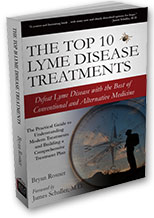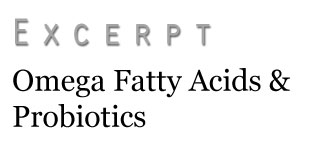|

Author Ken Singleton, M.D.
Excerpts from the Lyme Disease Solution:
Table
of Contents
Introduction
Chapter 1
Chapter 2
Chapter
3
Chapter 4
Chapter 5
Chapter 6
Chapter 7
Chapter 8
Chapter 9
Index
See our complete selection
of Lyme disease books and DVDs.
Customers who purchased The Lyme Disease Solution also
purchased the following book:

The Top 10 Lyme Disease
Treatments by Bryan Rosner
|
|
Paperback Book, 523 Pages, $29.95

Essential Fatty Acids (EFAs)
Essential fatty acids are unsaturated fats and oils that are vital for good health. They cannot be manufactured by the body and, in that sense, they are similar to vitamins. There are two main types of EFAs: omega-3 and omega-6 oils. Most Americans are out of balance in terms of their intake of these EFAs due to inadequate omega-3 food intake and excessive intake of poor quality sources of omega-6 fats and oils.
Omega-3 oils: The major usefulness of these oils in the treatment of Lyme is their potent anti-inflammatory effects. They also improve kidney function and are a major fatty acid source for the brain. They further enhance hormone production of growth hormone, thyroid, insulin, progesterone, and ACTH. Omega-3s stabilize moods and clinically have been shown to be beneficial in the treatment of depression. There are two sources of omega-3 oils.
Plant-source—There are many good plant sources of the omega-3 oil called alpha linolenic acid, such as oils of flax seed, hemp, perilla, soya, pumpkin seed, and walnut. Green leafy vegetables also contain some of these oils. (Canola oil contains omega-3s, but I generally don’t recommend the regular use of this oil for cooking.) When ingested in this alpha linolenic plant-source form, the omega-3 oil must be converted by the body to the active form by an enzyme called delta-6 desaturase. Unfortunately around 25 percent or more of the population does not make this conversion efficiently. This rate of poor conversion is even higher for people who are chronically ill, such as with chronic Lyme disease. For this reason, I generally recommend that most of the omega-3s come from animal sources.
Animal-source—Eating oily fish like wild-caught salmon or sardines, or using purified, mercury-free fish oil supplements at the dose range of 1,000–4,000 mg per day would comprise the most efficient methods of obtaining omega-3 oils. Additional useful sources would include animal products such as venison, free-range chicken and eggs, or beef whose diet was grass-based instead of grain-based. The advantage of the animal sources is that the animals have already converted the alpha linolenic acid in their diet to the active omega-3s called eicosapentaenoic acid (EPA) and docosahexaenoic acid (DHA).
Omega-6 oils: Two of the most common dietary sources of omega-6 oils are commercial grain-fed meats and vegetable cooking oils. It is true that omega-6 oils are essential, but each of these two common sources has a serious pro-inflammatory downside. Because of their pro-inflammatory potential, I recommend that my Lyme patients minimize their intake of the aforementioned common sources of omega-6s.
Alternatively, instead of commercial meats, use free-range and organic fish and meats (not corn-fed), which are lower in arachidonic acid (a pro-inflammatory type of omega 6). Instead of cooking with omega-6 oils, such as corn and safflower oils, use monounsaturated oils such as olive oil.
The therapeutic and healthiest form of omega-6 oils that I recommend is gamma-linoleic acid (GLA). Food sources are limited and include blue green algae and oatmeal (slow cooked). Most GLA comes from the conversion of vegetable oils rich in linoleic acid (LA) by delta-6 desaturase, the same enzyme that converts the omega-3 oils to their active form. Due to chronic illness and the aging process, many people are unable to convert vegetable oils (LA) to GLA. The result is a relative deficiency of GLA despite often significant intake of the precursor vegetables oils. Combining this problem with an excessive intake of arachidonic acid, it is a setup for pro-inflammation.
For these reasons, it is usually important to supplement the diet with GLA. The most useful supplement sources of GLA originate from black currant, borage, and evening primrose oils. These oils are not pro-inflammatory. The usual supplemental GLA dosage recommendation is 240–960 mg a day. High quality supplements containing both omega-3 and omega-6 are also available.
Probiotics
Along with a high-quality multiple vitaminmineral- CoQ10 supplement and an excellent supplement of essential fatty acids (EFAs), a good probiotic supplement is the third “essential” supplement that I recommend to all my Lyme patients. “Probiotics” is the term given to healthy bacteria that help to maintain the health of the gut (small and large intestines).
Antibiotics used to kill Lyme and the TBDs also, unfortunately, kill off these normal, beneficial bacteria. This unfortunate “friendly fire” kill-off makes it easier for harmful microorganisms such as Candida albicans (which causes yeast overgrowth) to take over the gastrointestinal tract. Therefore, the foremost purpose of probiotics is to re-establish the normal protective microflora that colonize the walls of the intestinal tract. When these healthy organisms are present in large numbers, harmful microorganisms are kept in check. (This process is called competitive exclusion.)
One symptom of inadequate numbers of healthy probiotic bacteria with possibly excessive growth of harmful organisms is “antibiotic-associated diarrhea” (AAD). To prevent this abnormal situation from developing, probiotics should be taken at the outset of any antibiotic usage. To correct an AAD problem that occurs while on antibiotics, it often requires large amounts of probiotics be administered, using a high quality, complete probiotic formula. For a therapeutic effect, a probiotic formula must have the right varieties of beneficial organisms and right amounts of these healthy bacteria.
If you would like
to learn more about the book before ordering it, feel free to browse
these excerpts, which are available online, free of charge:
Table
of Contents • Introduction
• Controversy
and Background
Symptoms
• Testing
and Diagnosis • Natural
Killer (NK) Cells
Anti-Inflammation
Diet • Medical
History and Physical Exam
Low
Dose Naltrexone (LDN) • Food,
Diet, and Omega Fatty Acids
Hope
and Positive Outlook • Index
"What I have accomplished with this 500+ page book, The Lyme Disease Solution, is to share my everyday knowledge and practical experience of 10 years as a Lyme-enlightened practitioner (who also is himself a Lyme-survivor). Although I hesitate to use the “cure” word in relation to chronic Lyme, the principles in this book have resulted in a greater than 90% response rate in my patients. At least 60% of my patients achieve long-term improvement that allows them to get off of antibiotics completely."
— Ken Singleton, M.D.
|
THE LYME DISEASE SOLUTION
By Ken Singleton, M.D.
Foreword by James A. Duke, Ph.D.
Paperback Book, 523 Pages, $29.95 + $7 Shipping & Handling |
|

|
Order By Phone: |
Order Online: |
| (530) 541-7200 |
 |
 |
BioMed
Publishing Group
P.O. Box
9012
South Lake
Tahoe, CA 96150
www.LymeBookStore.com
Contact Us
(801)
925-2411
|
Disclaimer:
The
products offered on this web site are intended for
informational and educational purposes only and are not
intended to prevent, diagnose, treat, or cure disease.
The statements on this web site have not been evaluated by
the United States Food and Drug Administration. If you have
a medical problem see a licensed physician.
Copyright
© 2007 BioMed | Advertise
with us
|
|
